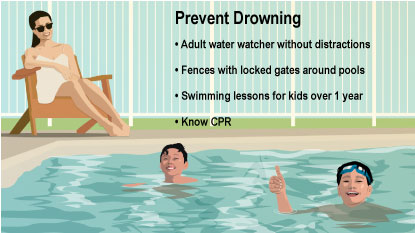Drowning is a leading cause of death in children and teens. It happens fast and is usually silent. Be sure to use many types of protection to protect kids from drowning. You never know which one will save a life.

Among young children, most drownings happen in home pools or hot tubs. In teens, drowning is more likely to happen in oceans, lakes, and rivers. Take these precautions:
Assign a Water Watcher
There should always be an adult water watcher (at least 16 years old) while children are in and around a pool or any body of water. At a party, have adults take turns as water watcher. Even if a lifeguard is on duty, a water watcher also should watch kids.
The water watcher should:
Use Fences/Alarms/Covers
To keep children safe near pools and hot tubs:
Have Kids Take Swim Lessons
Schedule swimming lessons for kids older than 1 year old. Swim lessons do not replace the need for a water watcher and other safety precautions, but learning to swim makes drowning less likely. Check with your local recreation centers or search the Red Cross website for classes taught by a qualified instructor. Ask about free or reduced-rate lessons. If you don't know how to swim, consider taking lessons too.
Learn CPR
Every parent should know how and when to do CPR. It brings blood to the heart, brain, and other organs and starts breathing until health care providers can give a person advanced life support. Done correctly, CPR can save a person's life. Search the Red Cross website for classes taught by a qualified instructor.
Use Life Jackets
Children and adults should wear Coast Guard–approved life jackets while on a boat (even if they can swim). This will help protect them from drowning if they are suddenly thrown into the water. Water wings and other "floaties" do not protect children from drowning. Life jackets and "floaties" should be used along with — not instead of — adult supervision.
No Alcohol or Drugs
Do not use alcohol and/or drugs while driving a boat, acting as a water watcher, or swimming. Alcohol use increases the risk of drowning while swimming or boating.
Home Safety
To prevent drownings in and around your home:
Talk to Teens
Even teens who are strong swimmers are at risk of drowning. Be sure your teen knows how to swim. And talk to them about never swimming alone, only swimming where a trained lifeguard is on duty, and never drinking alcohol or using drugs while near or in water.